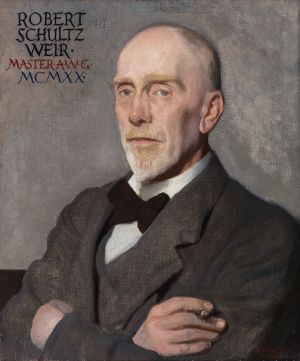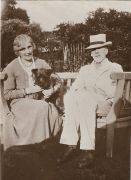Robert Weir Schultz: Difference between revisions
Jump to navigation
Jump to search
No edit summary |
No edit summary |
||
| (2 intermediate revisions by one other user not shown) | |||
| Line 1: | Line 1: | ||
[[File:201806 ArtistsGuild Schultz Weir Robert 915.jpg|thumb|Robert Weir Schultz as Master of the Art Workers Guild]] | |||
'''Robert Weir Schultz''' (1860–1951) was a Scottish Architect. He worked extensively for the [[third Marquess of Bute]], including the restoration of [[Falkland Palace]]. In 1898 he advised on the lowering of the street level in [[Brunton Street]]. He designed the fittings for the [[Chapel Royal]], which were made by [[Robert Miller]] and paid for by Lady Bute. | '''Robert Weir Schultz''' (1860–1951) was a Scottish Architect. He worked extensively for the [[third Marquess of Bute]], including the restoration of [[Falkland Palace]]. In 1898 he advised on the lowering of the street level in [[Brunton Street]]. He designed the fittings for the [[Chapel Royal]], which were made by [[Robert Miller]] and paid for by Lady Bute. | ||
==Further images== | |||
<gallery mode=packed style="text-align:left"> | |||
File:R W Schultz cropped.jpg|thumb|Robert Weir Schultz and his wife, c. 1933 | |||
</gallery> | |||
[[Category:Artists and architects]] | [[Category:Artists and architects]] | ||
Latest revision as of 15:11, 5 January 2022

Robert Weir Schultz (1860–1951) was a Scottish Architect. He worked extensively for the third Marquess of Bute, including the restoration of Falkland Palace. In 1898 he advised on the lowering of the street level in Brunton Street. He designed the fittings for the Chapel Royal, which were made by Robert Miller and paid for by Lady Bute.
Further images
-
Robert Weir Schultz and his wife, c. 1933
